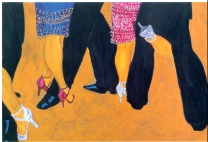 Stage performances of Argentine tango are typically choreographed, but as a social
dance, Argentine tango is highly improvisational. Drawing from their knowledge
of tango movements, dancers construct phrases of motion as they dance rather
than reproduce pre-set patterns. Improvisation allows the dancers to navigate
crowded dance floors, as well as to express themselves in a non-verbal
manner.
Stage performances of Argentine tango are typically choreographed, but as a social
dance, Argentine tango is highly improvisational. Drawing from their knowledge
of tango movements, dancers construct phrases of motion as they dance rather
than reproduce pre-set patterns. Improvisation allows the dancers to navigate
crowded dance floors, as well as to express themselves in a non-verbal
manner.
Because it is an improvisational dance, Argentine tango does not have any generally accepted or official syllabus to define its accepted vocabulary, but it does have defining parameters. No specific set of steps, figures, patterns, or structural elements define what Argentine tango is, although they are useful pedagogic devices for learning to dance Argentine tango.
In the absence of conventional definitions of tango dancing, a question arises as to what defines what is and what is not accepted as Argentine tango dancing. Louis Armstrong once said something like, "If you have to ask what jazz is, you will never get it." For me, attempting to define what is Argentine tango raises the same problems. I describe instead how the defining parameters of tango are established and evolve.
Argentine tango dancing has many similarities with jazz music in that there are no institutionalized rules for its improvisation, but there are common practices or idioms. Those who study jazz music or Argentine tango dancing learn the respective idioms. In that sense, the common practices become the parameters by which the art form is loosely defined by its practitioners.
Trying to clearly delineate what is Argentine tango and what is not is fraught with the same difficulties as trying to establish a clear definition of jazz music. Like jazz music, dancing Argentine tango is an art form that exists in a subculture, and as such, what defines its parameters or limits is what is accepted by the subculture. That is, evolving social custom determines which movements are considered part of the dance, and which are not.
Given what we have described for Argentine tango—a subculture with unwritten standards of practice—an informal group of insiders, probably the best dancers in the city most central to Argentine tango, Buenos Aires, are likely to exert the greatest influence over what and what is not considered Argentine tango. The standard for admission to this inner circle of influence is the high respect of the other practitioners.
Those who have not earned a position in the inner circle have substantially less influence on the parameters, if any at all. For the majority of tango dancers, conforming to the accepted practices laid down by one or more of the masters will determine whether they are dancing Argentine tango or doing something else. And perhaps surprisingly, these informal cultural parameters of acceptance can often be more strictly enforced than written laws enforced by police.
None of this should be taken to mean that Argentine tango is a museum piece or a cultural icon that is protected by an academy like the French language. On the contrary, we are describing something that is accepted as common usage in the subculture, where the usage evolves over time. Evolution occurs as the subculture is changed by the deaths of insiders, the emergence of new insiders, innovations by insiders, and influences from the outside.
All of this said, the individuals most likely to influence the direction of changes in Argentine tango dancing are those who have earned acceptance in the inner circle by achieving sufficient mastery of the dance within the existing, but implicit, parameters. Having achieved such status, they are in the position to offer defining changes to the art form.
Pablo Picasso mastered the existing art idioms before helping to introduce modern art. Miles Davis and John Coltrane were well accepted as bebop musicians before they helped to create modal jazz. Bob Dylan was well accepted as a folk singer before he helped to create folk rock music. Astor Piazzolla was well accepted as a tango musician before he helped create tango nuevo. Juan Carlos Copes and Maria Nieves were well accepted as outstanding dancers of Argentine tango before they helped to introduce innovations into tango dancing.
Despite their acceptance as masters of an existing genre, most individuals who offer defining changes to their art form are seen as controversial in their own time. Their works and motivations are carefully scrutinized—particularly by those most attached to the previously established practices in the art form. Despite their obvious dance skills, Gustavo Naveira, Fabian Salas, and some others who worked with them have encountered much controversy in offering a new style of tango.
What about the innovations offered to Argentine tango dancers by those outside the inner circle? In rare cases, where the ideas are quickly adopted by a well-accepted insider, such ideas can affect the acceptability, and perhaps simultaneously catapult an outsider into the inside circle. In the vast majority of cases, however, the innovations offered by outsiders will be rejected as inauthentic—that is, not conforming to the parameters of Argentine Tango as defined by the subculture itself.